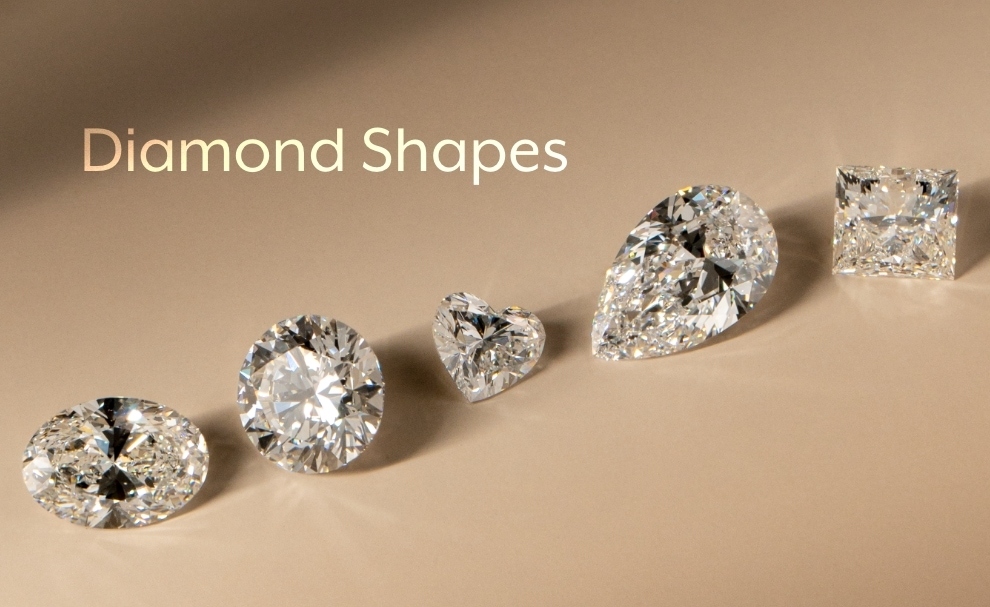
Diamonds have long been regarded as symbols of luxury, commitment, and beauty. Over time, they have been available in various shapes, each offering its own unique appeal. Whether you’re purchasing a diamond engagement ring or simply fascinated by the world of diamonds, understanding diamond shapes is essential. In recent years, lab-grown diamonds have also gained prominence in the jewelry industry. These diamonds are identical to mined diamonds in terms of their physical and chemical properties but are created in a laboratory setting. In this article, we will explore different diamond shapes and the growing trend of lab-grown diamonds.
Table of Contents
ToggleThe Different Diamond Shapes
When it comes to diamond shapes, there is a wide variety to choose from. Each shape has its own characteristics that make it suitable for different types of jewelry and personal preferences. Understanding diamond shapes can help you make an informed decision, whether you’re shopping for engagement rings or other diamond jewelry.
The most popular diamond shape is the round brilliant. This shape is designed to maximize the diamond’s brilliance and sparkle, making it a popular choice for engagement rings. The round shape is versatile, flattering for most hand shapes, and can be paired with almost any ring setting. Other popular diamond shapes include princess, cushion, emerald, oval, and radiant. Each shape has its own distinct qualities that can be suited to various tastes. Princess diamonds, for instance, are square-shaped with pointed corners, offering a modern and elegant look. Meanwhile, the cushion cut is a mix between round and square shapes, providing a softer and more romantic appeal.
Lab Grown Diamonds: A Modern Innovation
Lab-grown diamonds, also known as synthetic or man-made diamonds, are diamonds created through technological processes that mimic the natural conditions under which diamonds form in the Earth. Lab-grown diamonds are composed of the same material as mined diamonds, carbon atoms arranged in a crystal lattice. The primary difference is that lab-grown diamonds are produced in a controlled laboratory environment, often using two methods: High Pressure High Temperature (HPHT) and Chemical Vapor Deposition (CVD).
Lab-grown diamonds have gained attention because they offer a more sustainable and ethical alternative to mined diamonds. As these diamonds are created in laboratories, they do not require the extensive mining processes that can damage the environment and displace communities. Furthermore, lab-grown diamonds are free from the ethical concerns often associated with conflict diamonds. As a result, more consumers are choosing lab-grown diamonds for engagement rings and other fine jewelry.
The Quality of Lab Grown Diamonds
One of the most appealing aspects of lab-grown diamonds is their quality. Lab-grown diamonds are virtually indistinguishable from natural diamonds, especially when it comes to their appearance, hardness, and chemical composition. Both types of diamonds are graded using the same standards of the 4 Cs: cut, color, clarity, and carat weight.
Lab-grown diamonds can exhibit high levels of clarity and color, often ranking as high as mined diamonds. Since they are created in a controlled environment, lab-grown diamonds can be produced with fewer impurities and blemishes, resulting in diamonds that are often cleaner and brighter. Additionally, lab-grown diamonds are available in a wide variety of shapes, offering the same versatility as natural diamonds.
The Rise of Lab Grown Diamonds in Popularity
As consumer awareness grows, lab-grown diamonds are becoming increasingly popular. The appeal lies not only in their ethical and environmental benefits but also in their cost-effectiveness. Lab-grown diamonds tend to be more affordable than mined diamonds, making them an attractive option for those who want the beauty of a diamond without the high price tag.
Many jewelers now offer lab-grown diamonds, and these diamonds are often available in a variety of shapes, from the classic round to more unconventional cuts like heart or marquise. The ability to purchase high-quality diamonds in unique shapes at a lower price is appealing to many buyers. Additionally, the growing trend of lab-grown diamonds in the jewelry industry reflects a broader shift towards sustainability and conscious consumerism.
Diamond Shapes and Lab Grown Diamonds in Engagement Rings
When choosing an engagement ring, the shape of the lab grown diamonds plays a significant role in the overall design. Round diamonds are often chosen for their timeless appeal and brilliance, while other shapes like oval and princess diamonds are selected for their modern, contemporary look. Lab-grown diamonds are available in all the same shapes as natural diamonds, making it easy for consumers to find the perfect diamond for their engagement ring.
Some couples are drawn to the environmental and ethical benefits of lab-grown diamonds, while others appreciate the cost savings. Regardless of the reason, lab-grown diamonds are being embraced in engagement rings and are increasingly seen as a viable alternative to mined diamonds. The variety of diamond shapes available in lab-grown diamonds ensures that each individual can find a style that suits their personality and taste.
Conclusion: The Future of Diamond Shapes and Lab Grown Diamonds
As the popularity of lab-grown diamonds continues to grow, the variety of diamond shapes will only expand. Consumers can expect to find diamonds in virtually every shape imaginable, from traditional round brilliants to more avant-garde cuts like heart-shaped or pear-shaped diamonds. Lab-grown diamonds are paving the way for a more ethical and sustainable future for the diamond industry, while also offering a more affordable option for buyers.
Understanding diamond shapes is crucial when selecting the perfect diamond for your jewelry, whether it’s an engagement ring or a necklace. And with lab-grown diamonds offering both quality and value, it’s clear that this trend is here to stay.




 Hello, I'm Daryl Vandeventer, an accomplished and versatile freelance professional with a strong passion for delivering top-tier solutions to clients worldwide. With a diverse background and years of experience, I've honed my skills and am committed to helping individuals and businesses achieve their goals.
Hello, I'm Daryl Vandeventer, an accomplished and versatile freelance professional with a strong passion for delivering top-tier solutions to clients worldwide. With a diverse background and years of experience, I've honed my skills and am committed to helping individuals and businesses achieve their goals.